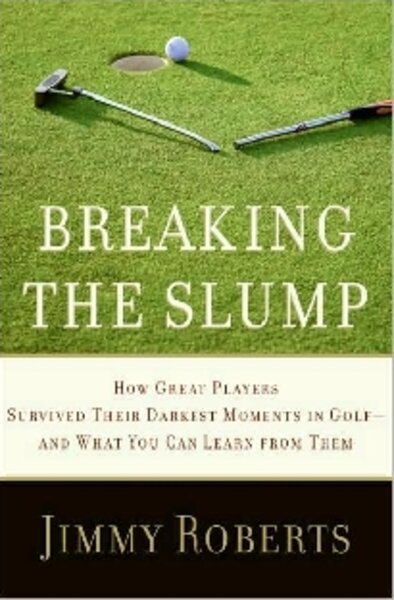Breaking the Slump
Loading...
If you’ve ever struggled to reach your goals on the links (and honestly, who hasn’t?), check out both Breaking the Slump by NBC-TV sports commentator Jimmy Roberts and Golf’s Sacred Journey by David L. Cook. Each takes a completely different approach. “Breaking the Slump” is based on the real-life advice of the pros. “Golf’s Sacred Journey” is a novel but has a ring of authenticity and a quality of writing that makes it compelling, too.
Why do great athletes – in this case, golfers – fall into slumps? And how do they find their way back? Roberts sat down with 16 top golfers to find the answer in “Breaking the Slump.”
What’s impressive about this book is whom Roberts interviews. Probably by virtue of his day job, he has access to the Who’s Who of the professional golf world (plus a couple of celebrity golfers), including Nicklaus, Mickelson, Palmer, and Watson – to drop a few names. Most people won’t remember Palmer’s or Nicklaus’s slumps. But David Duval’s fall from No. 1 on the tour is a more recent event – as is his comeback.
Perhaps not too surprisingly, one of the take-aways is that excellence stems from more than physical prowess or athleticism. Every sport has a mental dimension. At the highest levels of golf, the mind can be the difference between first and last place. “The most difficult course is five inches long. That’s the distance between your ears,” says Ben Crenshaw (currently No. 36 on the 2009 Champions Tour money list) quoting golf legend Bobby Jones.
British golfer Justin Rose (currently 92 on the 2009 PGA tour money list) tells Roberts: “You have to invest in your mind. It’s a muscle, and it does need to be trained. You don’t just become mentally strong.”
Slumps can be caused by anything from a technical hitch to burnout to travel. In 1976, Johnny Miller was unbeatable. He won the British Open and had a pro career total of 18 tournament victories. But he also had a wife and four children under the age of 6 at home. He nose-dived from No. 2 on the golf tour’s money list to No. 112 in two years. Why? “Every chance he got to play the game he loved forced him to leave the ones he loved,” writes Roberts.
Miller was on the verge of quitting. But, he says, he came across a scriptural passage to the effect that, “it’s not what you accomplish in life that matters, but what you overcome that proves who you are or what kind of a man you are.”
Miller, a Mormon, tells Roberts: “I’ve never overcome anything. How can I quit now? What are my kids going to think?” His children became his inspiration for a comeback, where he won several tournaments between 1980-83. Miller didn’t reach No.1, but he was back among the elite.
Everyone Roberts interviews has a different formula for breaking out of a slump. But some of the common denominators include taking a break (Nicklaus and Palmer), focusing on the fundamentals, developing a go-to shot, and simply rebuilding your confidence.
Roberts concludes: There’s no one way to fix a slump. But don’t give up. Eventually you’ll find the answer. “It’s like walking through a marketplace where everyone is babbling in a foreign language, and then suddenly, amidst the incomprehensible din, you’ll hear a voice clearly speaking in your native tongue,” he writes.
“Golf’s Sacred Journey” by David L. Cook is a hard book to put down. I confess that I’m a sucker for redemption stories. The plot is about a professional mini-tour player striving to make the PGA tour, but he’s had one too many blowups on the course and is on the verge of quitting. His obsession with golf has pretty much ruined his life. He stumbles upon an old rancher, a former golf instructor, who promises: Give me a week and you’ll find your game.
What follows is a series of unorthodox lessons, including an art class, a flight lesson, and day of fly-fishing that is about finding one’s mental poise.
Golfers love to equate the sport with life. But in this case, this is a book that golfers and nongolfers will enjoy. It’s about finding control and perspective, and understanding that peak performance in any activity is based on more than technique.
I loved this story and the telling of it. But when I hit Chapter 9, I got mad. I felt duped. This chapter is about accepting God as your saviour. This was the first inkling that there was another agenda. It was a little like going to a golf lesson and finding a Tupperware pitch at the end.
But I couldn’t put the book down. I finally concluded that this story is about much more than golf, and if this man’s path out of a meaningless pursuit of a golf score was by finding a deeper understanding of what’s really important in life – helping others – so be it. And, I have to admire the author for the quality of the pitch to accept the Christ; it was gentle, undogmatic, and unconventional.
I would recommend “Golf’s Sacred Journey” to anyone, but I’d give them a heads up about where it’s heading.
David Clark Scott is the Monitor’s International news editor and chronic high handicapper.






